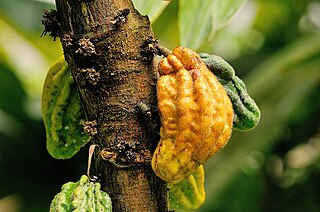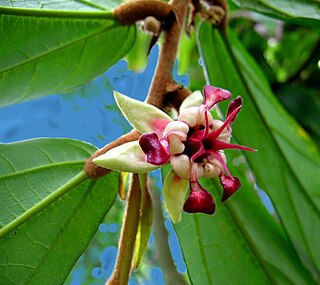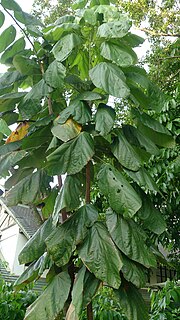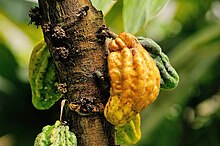
The Malvales are an order of flowering plants. As circumscribed by APG II-system, the order includes about 6000 species within 9 families. The order is placed in the eurosids II, which are part of the eudicots.

Theobromine, formerly known as xantheose, is a bitter alkaloid of the cacao plant, with the chemical formula C7H8N4O2. It is found in chocolate, as well as in a number of other foods, including the leaves of the tea plant, and the kola nut. It is classified as a xanthine alkaloid, others of which include theophylline and caffeine. Caffeine differs from these compounds in that it has an extra methyl group (see under Pharmacology section).

Theobroma cacao, also called the cacao tree and the cocoa tree, is a small evergreen tree in the family Malvaceae, native to the deep tropical regions of Mesoamerica. Its seeds, cocoa beans, are used to make chocolate liquor, cocoa solids, cocoa butter and chocolate. The largest producer of cocoa beans in 2018 was Ivory Coast, with 37% of the world total.

Malvaceae, or the mallows, is a family of flowering plants estimated to contain 244 genera with 4225 known species. Well-known members of economic importance include okra, cotton, cacao and durian. There are also some genera containing familiar ornamentals, such as Alcea (hollyhock), Malva (mallow) and Lavatera, as well as Tilia. The largest genera in terms of number of species include Hibiscus, Sterculia, Dombeya, Pavonia and Sida.

Theobroma is a genus of flowering plants in the mallow family, Malvaceae, that is sometimes classified as a member of Sterculiaceae. It contains roughly 20 species of small understory trees native to the tropical forests of Central and South America. The generic name is derived from the Greek words θεός (theos), meaning "god," and βρῶμα (broma), meaning "food". It translates to "food of the gods."

Sterculiaceae was a family of flowering plants based on the Genus Sterculia. Genera are now placed in the Family Malvaceae, in the subfamilies: Byttnerioideae, Dombeyoideae, Helicteroideae and Sterculioideae.

Cauliflory is a botanical term referring to plants that flower and fruit from their main stems or woody trunks rather than from new growth and shoots. This can allow trees to be pollinated or have their seeds dispersed by animals that climb on trunks and sturdy limbs to feed on the nectar and fruits. With fruit, plants may instead have fruit which drop from the canopy and ripen only after they reach the ground, an alternative "strategy" to cauliflory.

Endoclita is a genus of moths of the family Hepialidae. There are 60 described species found in eastern and southeast Asia and the Indian subcontinent.

Abroma is a genus in the family Malvaceae, with one or two species from Asia and Australia. Ambroma is an orthographic variant.

Moniliophthora perniciosa is a fungus that causes "witches' broom disease" (WBD) of the cocoa tree. T. cacao a tropical tree with seeds that are processed into cocoa (=cacao) products. This pathogen is currently limited to South America, Panama and the Caribbean, and is perhaps one of the best-known cocoa diseases, thought to have co-evolved with cocoa in its centre of origin.

Moniliophthora roreri is a basidiomycete fungus that causes frosty pod rot disease, one of the most serious problems for cacao production in Latin America. This disease and together with witches’ broom disease and black pod rot constitute the cacao disease trilogy. It causes serious losses in southwestern parts of South America; spores are dry and powdery and are spread easily by water movement, wind, or movement of pods; disease spread is highest during periods of high rainfall.
Herrania balaensis is a species of flowering plant in the family Malvaceae. It is found only in Ecuador. Its natural habitat is subtropical or tropical moist lowland forests; it is fragmented due to colonization, mining, and deforestation.
Herrania laciniifolia is a species of flowering plant in the family Malvaceae. It is found only in Colombia.

Herrania umbratica is a species of flowering plant in the family Malvaceae . It is found only in Colombia.

Abroma augustum, sometimes written Abroma augusta, Devil's cotton, is a species of Abroma. It has dark red flowers with an characteristic and unusual appearance. It is widely distributed in Asia. It was previously thought to grow in north Queensland but the most recent survey did not find it.
Carmenta foraseminis is a moth of the family Sesiidae. It was described by Thomas Drake Eichlin in 1995, and is known from Panama, Colombia, Venezuela, and Brazil. The larva of the species have been found on plants of the species Gustavia angustifolia, Gustavia suberba, as well as plants in the genus Eschweilera, and on the pods of Theobroma cacao.

Byttnerioideae is a subfamily of the flowering plant family Malvaceae.

Corallomycetella is a genus of ascomycete fungi in the family Nectriaceae. Species of Corallomycetella are tropical, and are characterized by the formation of brightly colored rhizomorphs of their rhizostilbella-like asexual morphs. These fungi causes a number of plant diseases including 'violet root rot' of Theobroma cacao, root rot of Carica papaya, and 'stinking root disease' of several tropical woody plants. Two species of Corallomycetella are recognized: Corallomycetella elegans C. Herrera & P. Chaverri and Corallomycetella repens Rossman & Samuels. Corallomycetella jatrophae is now classified under Corallonectria.

Theobroma bicolor, known commonly as the mocambo tree, jaguar tree, balamte, or pataxte, among various other common names, is a tree in the genus Theobroma, which also contains the better-known Theobroma cacao. It is found in Central and South America, including stretches of the Amazon rainforest in Brazil, Colombia, Ecuador, and Peru.

Herrania mariae is a species of flowering plant in the family Malvaceae. It is native to South America - Colombia, Ecuador, Peru and Brazil. The fruits are locally used as food.

















